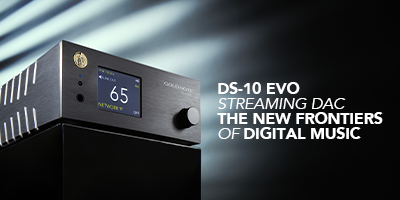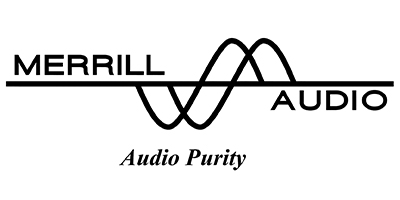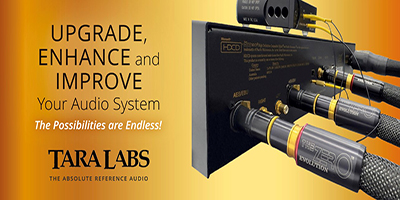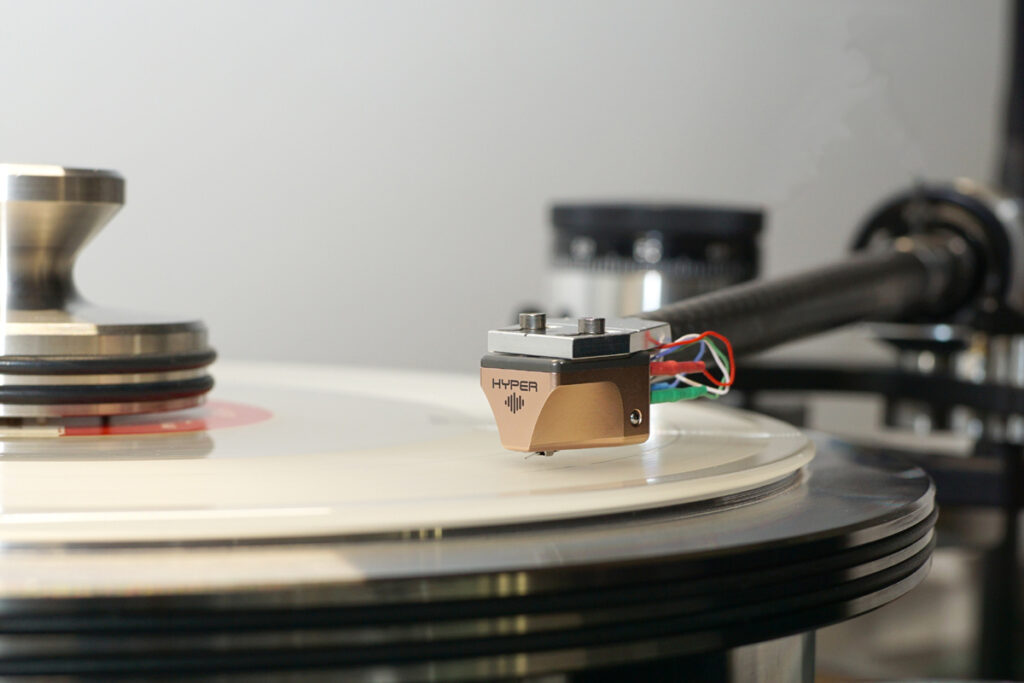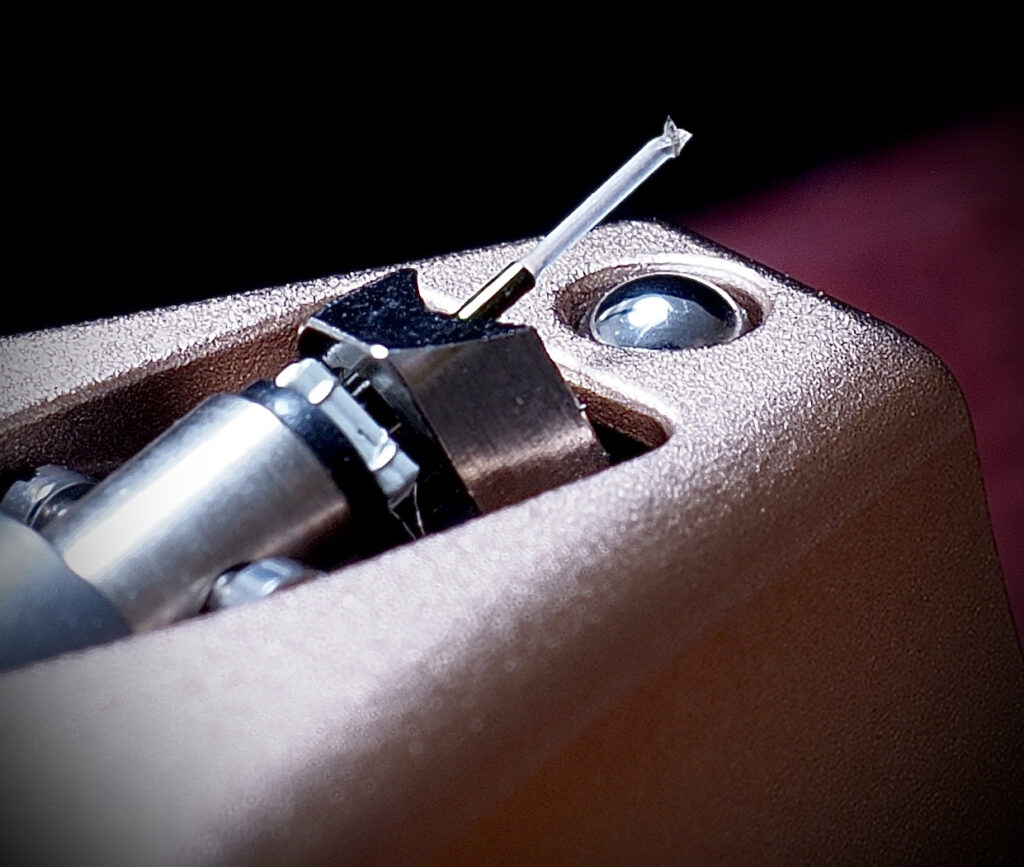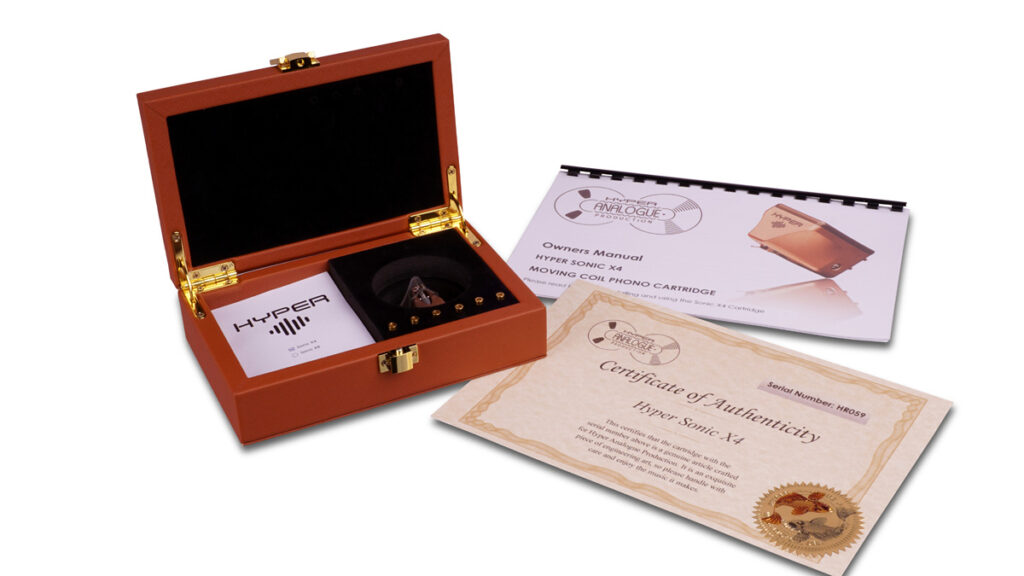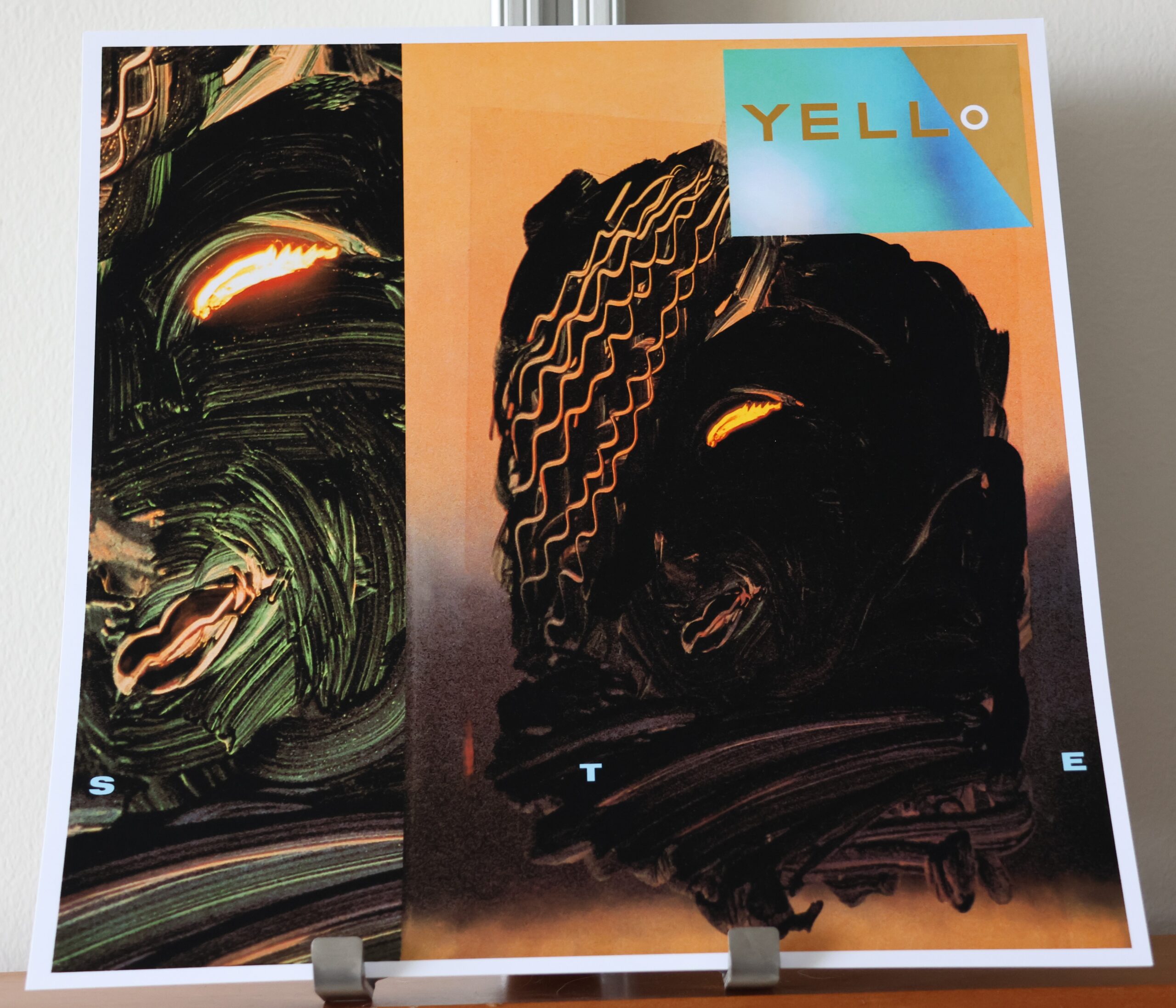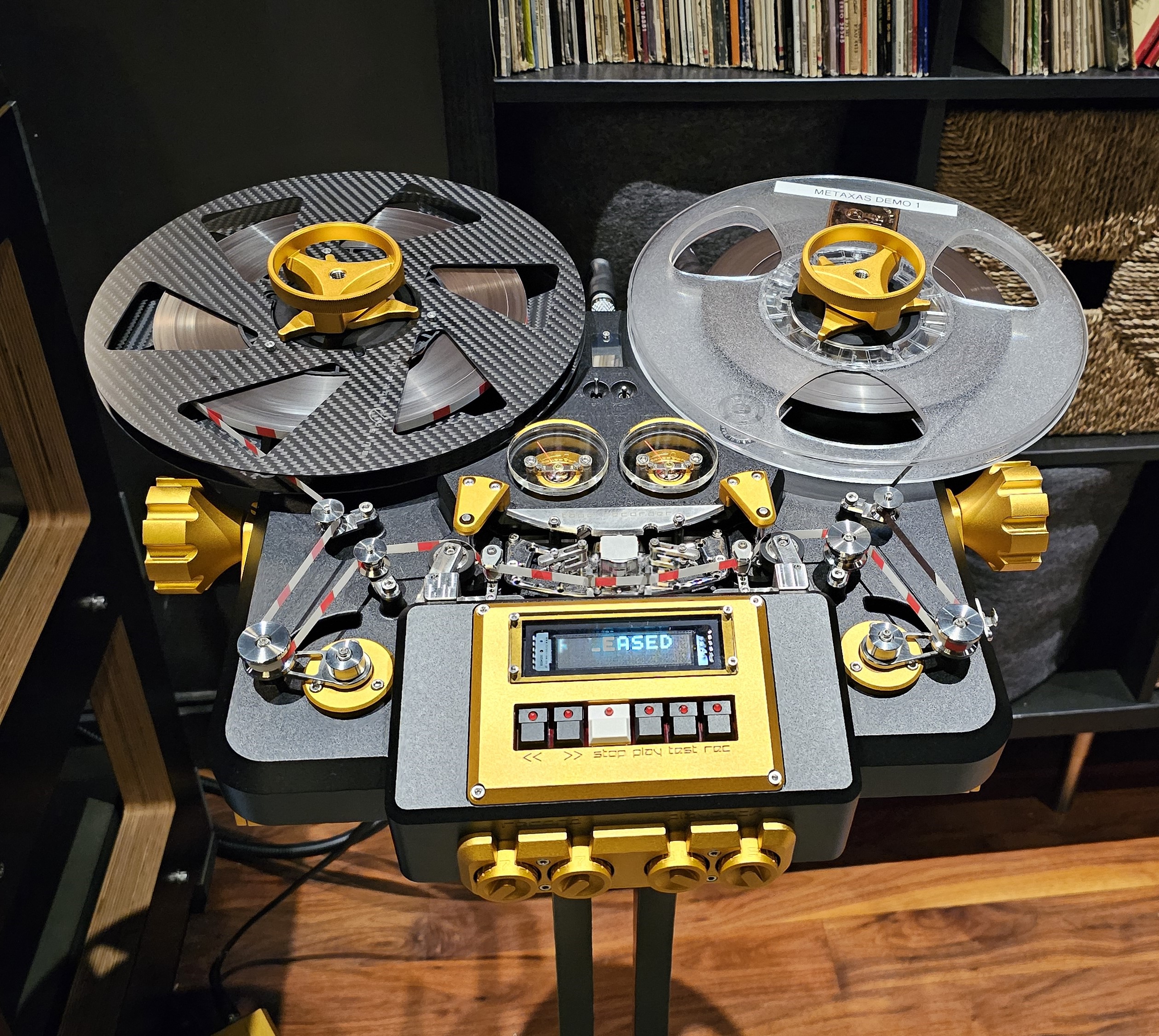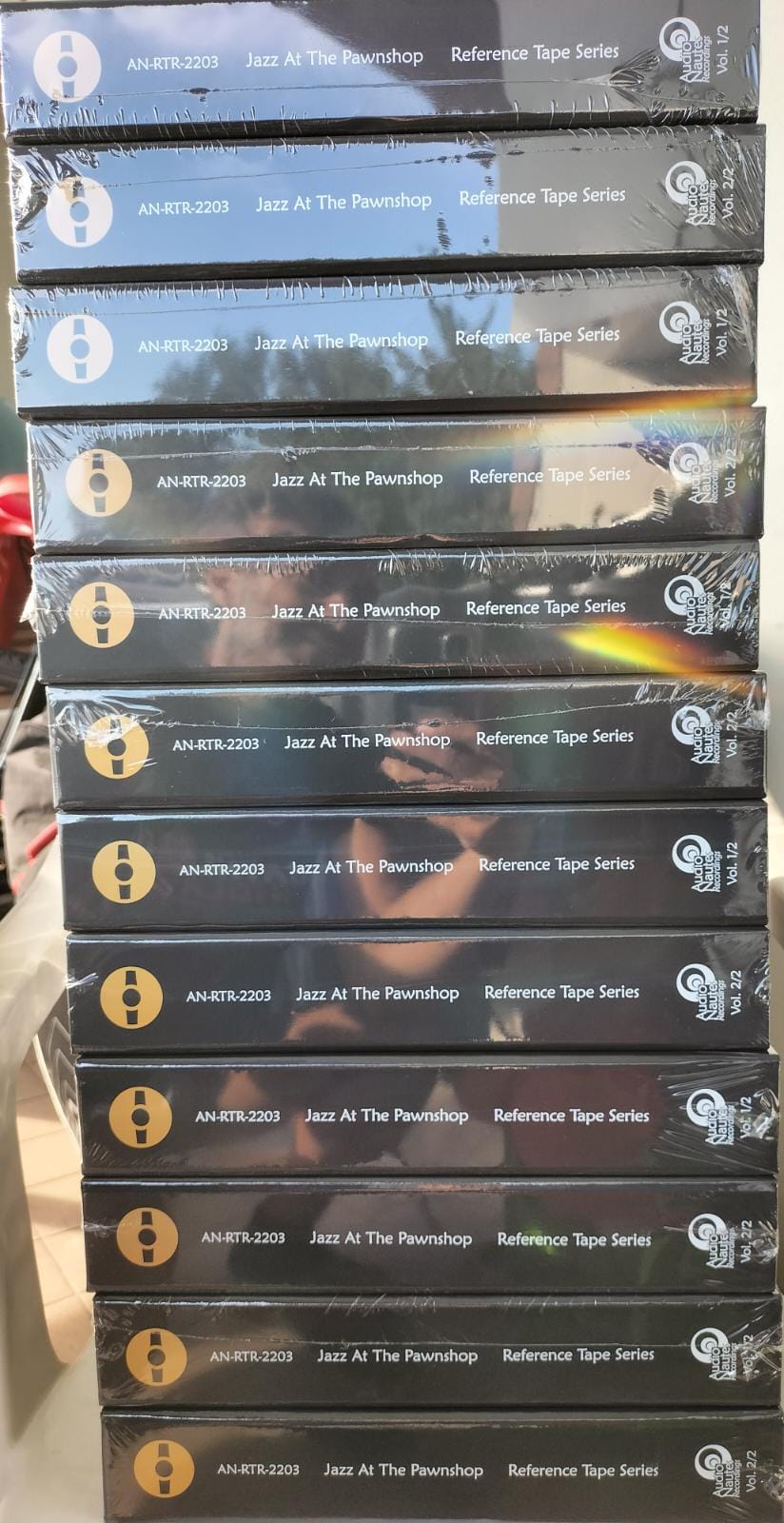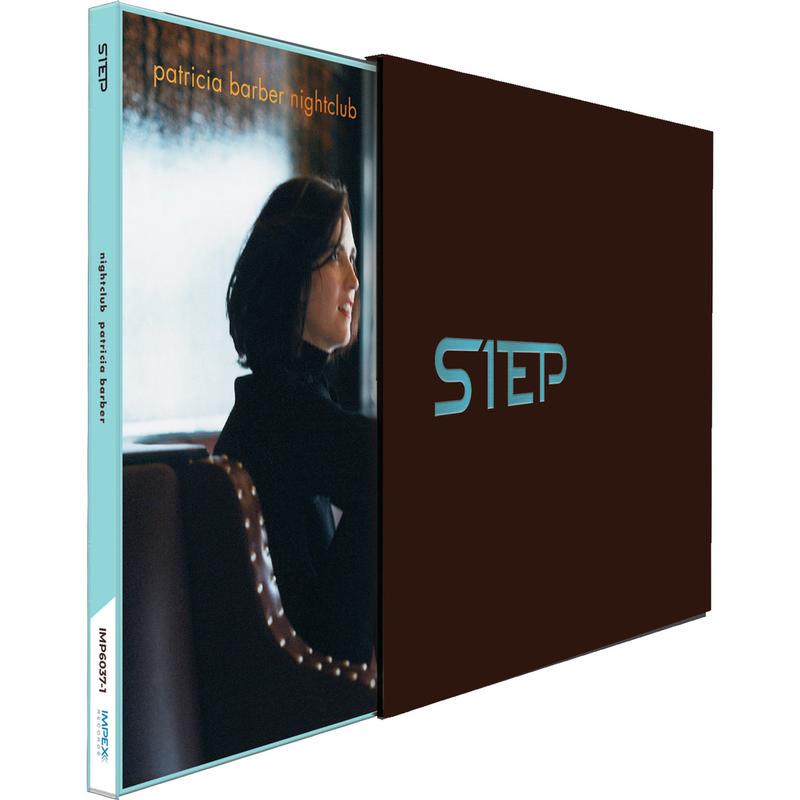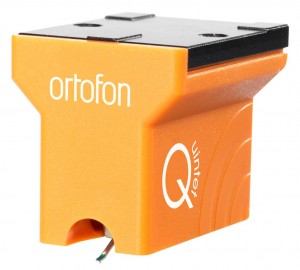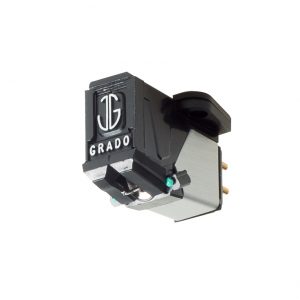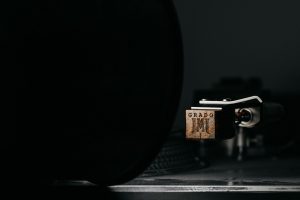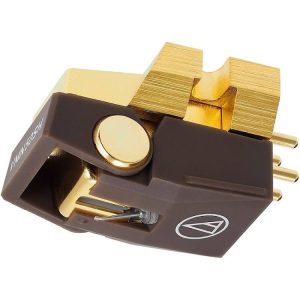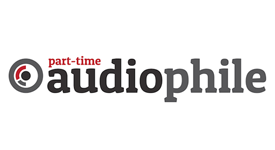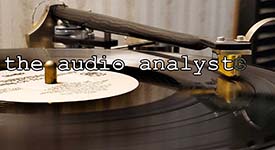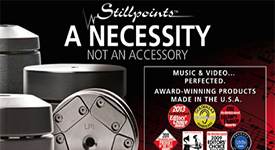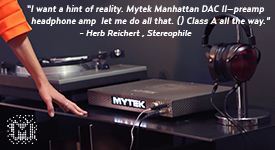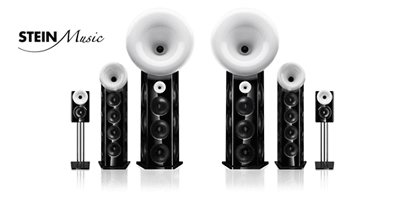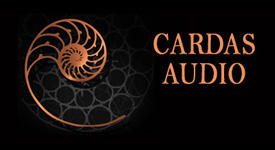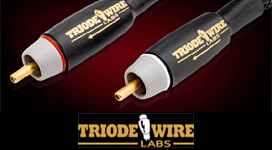My first encounter of the Hyper Sonic X4 cartridge kind occurred in the VPI room at Capital Audiofest 2023. The next year, Laurence Borden, proprietor of Distinctive Stereo in NJ, also turned to the Hyper Sonic X4 to anchor his vinyl playback setup at Capital AudioFest 2024. Both times I left the show incredibly impressed by the cartridge's speed, neutrality and resolution and was curious how much better the transducer would perform under home conditions. It turned out even better than first advertised.
The first moving coil cartridge from this new audio company was born from a multi-national consortium consisting of Wuti Larnroongroj (Thailand), T.K. Han (Singapore/Malaysia), Richard Tin and his boss (Hong Kong) and finally Gary Koh (US). "The team approach," Gary shared, "offered us the opportunity to do something that any single person could dream of. As a consequence, though, it took a long time. You know what they say about making decisions by committee." This talented team with a cumulative 150 years of shared knowledge and experience in music reproduction and equipment design spent two years working with Micha Huber of HiFiction (and EMT and Thales) before arriving at the final production version. Four rounds of prototyping later, the Hyper Sonic X4 cartridge was ready for prime time.
To quote HyperAnalogue, "…for extreme performance, with extreme specifications, everything matters. Every detail matters." And that becomes increasingly evident, the more one listens to the Hyper Sonic X4 cartridge and reads through the Technical Highlights section at the end of the review.
On The Record
The initial anticipation was quickly replaced with the need to get down to brass tacks. The Hyper Sonic X4 cartridge was mounted in the SAT LM-12 carbon fiber tonearm initially on the VPI Avenger Direct turntable and then later (and for the bulk of the review) on what I call the VPI Super Avenger Direct Drive turntable or more correctly, VPI's latest thinking on turntables, the Avenger Reference turntable with outboard Vanquish power supply. Without straying too far off topic, VPI's newest direct-drive table is an Avenger in name only. It's a totally different beast than their previous direct-drive table efforts in practically every way.
It goes without saying that attention to alignment and set-up counts with all cartridges and it's even more critical with a cartridge of this caliber. Down to meticulously cleaning the stylus! You owe it to yourself to go the extra yard with the Hyper Sonic X4 and hire a cartridge set-up expert to ensure the transducer is properly aligned and dialed in. Even to the point of setting the cartridge up, letting it break-in and then having them return to finally dial the transducer in. You can then rest easy that you're getting everything that you paid for out this state-of-the-art moving coil cartridge.
For the purposes of this review, the cartridge was (after allowing for break-in and a little experimentation) tracked at 2.1 g and loaded at 120 ohms (the loading value will vary depending on your system so please do experiment). The cartridge's relatively low output necessitates mating to a very quiet, high gain phonostage: that was in this instance Doshi Audio Evo phonostage with 72 dB of gain. I did try running the Hyper Sonic X4 with the Soulution 326 preamplifier's built-in phonostage and while it sounded good, it didn't have enough gain and the dynamics suffered.
The Reviewing Challenge Defined
The reviewing challenge in short: how to best evaluate a cartridge of this caliber? One can play it safe and take the tried-and-true approach of using some choice recordings to evaluate the cartridge's performance. But there must be a better option, something a bit more objective. And there is. Granted, the ultimate audiophile goal is capturing as much of the sound of live music as possible in our home; the reality, however, is that the master tape is the true reference. (Leaving direct-to-disc albums out of the discussion.) Luckily, I have on hand just for this occasion some early second and third generation 15-ips reel-to-reel tapes and their corresponding LPs from a host of labels including but not limited to Analogue Productions, 2XHD and Horch House that are (presumably) mastered from the same master tape just for this sort of occasion. At least the master tape used for both analog recordings is roughly the same age.
It goes without saying, though, that the odds are stacked in favor of reel-to-reel tapes before the comparisons even start. For instance, tape doesn't suffer from varying frequency response across the record, the bass generally isn't mono'd, dynamics are better especially in the low frequency regions and there's generally less compression. Yet vinyl has, despite these limitations, crept ever closer to the sound of tape over the many years. Particularly when talking about the areas of bass performance and dynamics. So, how did the Hyper Sonic X4 cartridge fare in these head-to-head comparisons? Read on.
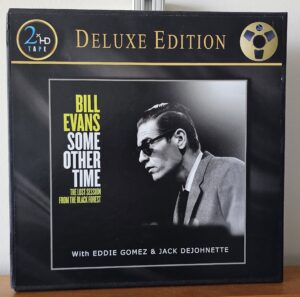
First up in the 15-ips reel-to-reel tape vs LP shootouts was the 2XHD release of Bill Evans Some Other Time V.2 (2XHDRE-V1239, 45 rpm LP; 2XHD HDRE-TB1044, 15-ips tape). Here, the 45-rpm lacquer was cut by mastering guru Bernie Grundman while the 15-ips reel-to-reel tape was copied by Rene LaFlamme on a custom, all Nagra/Doshi Audio electronics chain. The tape sounds magnificent. Evans' piano has a full and liquid sound and is surrounded by a billowing envelope of air. Each instrument lets you know its presence and you can close your eyes and imagine the musicians are in the room. The LP, by contrast, was slightly disappointing after listening to the tape. The sound of Evans' piano on the 45-rpm LP reissue leaned more toward the Riverside label Evans' piano sound (thinner and more metallic) than the richer MPS sound. Nor did the piano on the LP have as much of an envelope of sound surrounding the piano.
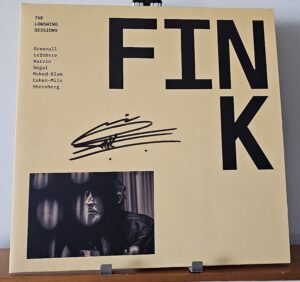
Ever curious, I decided to conduct a second set of 15-ips reel-to-reel tape vs LP comparisons using Fink's aka Fin Greenall's recently released (on tape anyway) The Low Swing Sessions (Low Swing Records, 45 rpm, LOSO010/sponsored by Brinkmann Audio; Horch House, 15-ips tape, Studio Master version). Fink's The Low Swing Sessions was recorded by Berlin based Guy Sternberg and his company Low Swing Records, a relative newcomer to the high-end audio music scene, in pure, unadulterated analog sound. Guy recorded this album using vintage or vintage-like microphones and put it down on a 24-track Studer 827 2-inch tape machine running at 30-ips and mixed down to a ½-inch Studer A80 tape machine also running at 30-ips. Either way, a whole lotta tape was used in this recording. For the curious among you, Guy used a Neumann M49 tube microphone to record the acoustic guitar on "Modern Love" and a Neumann KM54 tube microphone on the acoustic guitar on "Black Hole Sun." In this instance, the 45-rpm LP lacquers were cut by John Webber (Ray Staff's successor) at Air Studios in London and the tape copies by Guy Sternberg at Low Swing Records.
Low Swing Sessions features Brit Fink performing several ballad-type covers including Soundgarden's "Black Hole Sun" used in this comparison. Take my word for it. You're just going to love and swoon over Fink's version of "Black Hole Sun" and play the LP to death just to hear the ending of the song. The Low Swing Sessions LP differed from the 15-ips reel-to-reel tape primarily when it came to quantity not quality. In other words, the 15-ips reel-to-reel tape possessed a touch more ambience, information, presence and ease. You're just going to, nevertheless, have a meltdown when you hear the naturalness, inner detail and liquidity of Fink's vocals with either analog source. Naturalness being defined here as the absence of any artificiality or mechanical feel to the music. Ultimately, the sound of Low Swing Sessions 45-rpm LP proved closest to the sound of 15-ips reel-to-reel tape of all the comparisons.
This was hardly the expected outcome. Two wildly disparate results perhaps indicating that it wasn't simply the cartridge and LP's fidelity to the 15-ips reel-to-reel tape being tested but the quality of LP remastering, vinyl remastering system, etc.
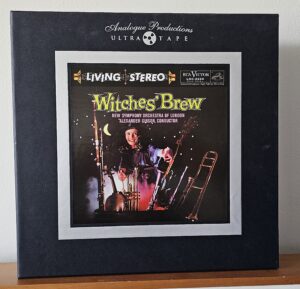
Last up (or so I thought). It was time to turn to an old and trusted friend to break the deadlock. That audiobuddy was that other worldly 1957 RCA/Decca Kenneth Wilkinson recording Witches Brew. Witches Brew, one of the few Living Stereos compilations, features Alexander Gibson conducting the New Symphony Orchestra of London performing a selection of bewitching, devilish tunes (Analogue Productions, 15-ips reel-to-reel, RRAP 02; LP, LSC-2225). It was the late Sid Marks of TAS and Ultimate Audio fame—not to mention my audio mentor—who initially introduced me to this outstanding recording in the mid-80s. To quote Sid from his RCA Living Stereo wrap-up published in my late magazine Ultimate Audio (Sid Mark's Final Rankings of the RCA Living Stereo Recordings - Audionirvana.org HERE. See posts 9 and 12) , "The overture to 'Tam O'Shanter' stands by itself as a powerhouse of sound on this disc of Satan's favorites. It is quite literally a riot of orchestral color, detail and full range dynamics." That said, there's absolutely nothing like hearing Witches Brew on tape! Large scale, dynamic music that puts every component in the system—not the least of which is the cartridge—to the ultimate test. In this case, the late William Makee in Germany remastered the LP and Gus Skinas dubbed the tapes for Analogue Productions. Malcolm Arnold's Tam O'Shanter on side one has served me well as a reference track for more than four decades and it didn't let me down here. Surprise! The sonic differences here between the 15-ips reel-to-reel tape and LP was even greater than with the Bill Evans. The tape possessed far more information, space and especially low end than its 12-inch cousin! So much more low end, in fact, that I wondered if I had missed an issue with the cartridge when evaluating other albums.
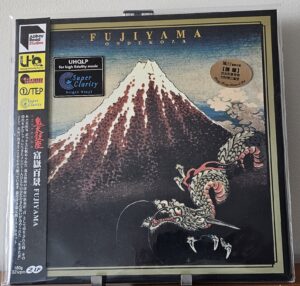
Nope there was nothing wrong with my ears. The truly the last set of comparisons used the recently released Miles Showell remastering of Ondekoza: Fujiyama (Modern Audio UHQLP 3115, One-step, ½-speed, clarity vinyl) vs. the 2018 UHQCD (Audio Meister GCAC-1023) edition just to double check my ears as well as the cartridge's low end performance. A big wow here. There's few better recordings on the planet to test a system's bass performance than this 1997 recording of Japanese Taiko drums laid down on the legendary Studer C-37 1-inch tape machine. (Yes, I assume the LP is digitally remastered but it's really good.) Here, the LP ruled the roost with its huge—and I do mean huge—soundstage, dynamic swings, low end authority and extension and three-dimensional solidity. The area, however, where the LP really put the UHQCD to shame lay in the areas of spaciousness, decay and reverb. It simply wasn't even close here. And did that sense of space ever bring the recording to life! The only area where the UHQCD was a smidge better—and we're nitpicking here—was in reproducing the transient speed and attack of the smaller drums. In retrospect, the lack of perceived bass on the reissued Witches Brew LP was the cartridge revealing the remastering process.
As Robert Burns penned in his poem To A Mouse: "The best laid plans of mice and men/Often go awry." A lot of time and effort expended in these aforementioned listening sessions with not a lot to show for it. Or was there? Four different recordings from four different companies with completely unexpected and unpredictable results. When the dust settled, it was the Hyper Sonic X4's resolution and its ability to resolve and discern differences between remasterings that came to the fore. For instance, the cartridge not only revealed the quality of a recording's lowest frequencies but their extension. The Hyper Sonic X4 also had a knack to resolve and recreate the sense of spaciousness and transport the listener to the studio or in the case of the best of classical works like Witches Brew to that "hall of halls" Kingsway.
Groove Notes
A few more candid insights into the sound of the Hyper Sonic X4. Male and female vocals stand out for their naturalness, tonal "resolution," (specifically tonal as opposed to overall sonic resolution, of which there's plenty, too) and sense of ease. The Hyper Sonic X4 cartridge possesses a simply stunning ability to create palpable, wrap your arms around, three-dimensional images. Two excellent examples are that popular tune from years ago "Fools Rush In (Where Angels Fear to Tread)" from Dean Martin's Dream with Dean (Analogue Productions 076-45) or that famous bossa nova jazz standard "Dindi" from the Pierre Sprey recording Shirley Horn: Softly (2XHD 45 rpm 2XHDHJA-V1140). Both mellow, both emotionally evocative recordings and both incredibly well served by the Hyper Sonic X4.
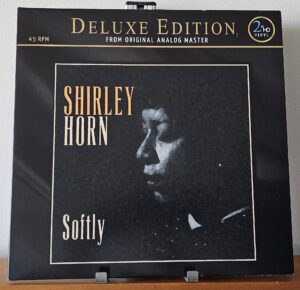
Digging down a little more into the Hyper Sonic X4's midrange. The cartridge's vanishingly low noise floor results in unprecedented levels of both clarity and transparency. Clarity, being the ability to see in the mind's eye the individual singer, performer, etc. as opposed to transparency that relates to seeing through the entire soundstage all the way to most distant reaches of the rear of the soundstage. That recovery of space buried in the noise floor (a nod here to the Soulution electronics!) that brings recordings to life and lifts a seemingly imperceptible veil between the listener and the performer. The cartridge's low noise floor, clarity and naturalness also enables listeners to more easily immerse themselves in the music. Performers—take Barney Kessel playing on Dream with Dean—just have that walk up to and shake their hand qualities. My listening notes include several references, such as on Dean Martin's Dream with Dean, to the experience of being in a club for the first time.
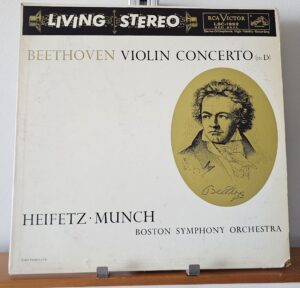
Another prime example of the Hyper Sonic X4's stunning midrange is "Cadenza Auer-Heifetz" from Beethoven's Concerto in D, Opus 61 with Charles Munch conducting the Boston Symphony Orchestra and Jascha Heifetz playing violin (take your pick of the original RCA Shaded Dog LSC 1992 or Classic Records 45 rpm reissue here). Concerto in D, Opus 61 is one of the masters' best-known pieces and shockingly his only violin concerto. This extremely early stereo recording (in this case 2-track) was originally recorded in 1955 and first released in stereo on 7½-ips, 2-track reel-to-reel tape in 1957. Concerto in D, Opus 61 didn't see the light of day on vinyl until 1959. And what a sonic and musical blockbuster that for some reason my beloved mentor Sid Marks overlooked in his A Full Deck of Living Stereos: The Top Sonic 52. "Cadenza Auer-Heifetz" really showcases the sweet and lush (especially on the original Shaded Dog version) but not syrupy tone of Heifetz's violin, musical contrasts and powerful interpretation. Heifetz's playing puts everything at ease. What also stands out with the Hyper Sonic X4 was the lack of brightness of high strings that often plagues this recording with other cartridges over the years. (Substituting Kubala-Sosna's Realization speaker cable for the AudioQuest Dragon Zero speaker cable also really highlighted the cartridge's tonal recreation of Heifetz's violin.) The same held true for the "Adagio di Molto" from Sibelius' Violin Concerto in D (RCA/Classic Records LSC 2435-45) with Heifetz. While brighter sounding than the Beethoven piece, Heifetz's violin never reached the point of shrillness on the Sibelius piece like other moving coil cartridges. Looking for some value added? Check out how the Hyper Sonic X4 delineates and reveals the inner details of the orchestra's string section.
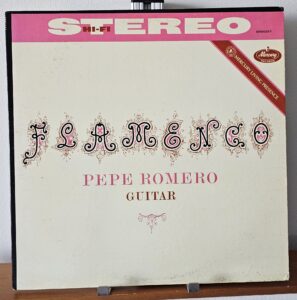
A few other reflections on the time spent with the Hyper Sonic X4 cartridge. The transducer's sheer, transient attack, resolution and speed are second to none. More to the point, the Hyper Sonic X4 doesn't exhibit that illuminated, hyperdetailed sound often encountered with many of the newest generation of diamond cantilever equipped cartridges. You've experienced it. It sounds like someone moved the microphone a couple of inches closer to the performer. Nor does the sound stand the test of time. Take for example, the sensational solo recording of Pepe Romero performing "Fandango por Verdiales" from Flamenco (original Mercury SR90297). Recorded by Robert Fine at Fine Recording Studios A, Flamenco really shows off the hallmark rasgueado strumming technique of flamenco guitarists. Machine gun-like rapidity of playing, strumming and melodic phrases that brings back memories of the Ikeda 9TT reviewed many, many years ago. One realizes quite quickly why flamenco music makes Spanish blood boil. All with a simple un-strained sense of ease and determination of a 100 meter sprinter. That sense of speed and resolution extends from the highest to the lowest reaches of the audio spectrum whether it be the lightning fast Taiko drums on "Ondekobayashi" from Fujiyama or the incredible airiness, shimmer and etherealness of the celesta on Dream with Dean.
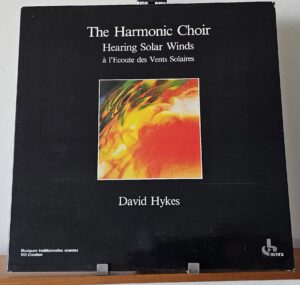
The Hyper Sonic X4 is at the same time capable of incredible subtlety and low level resolution. A splendid example of that is David Hykes' landmark recording Hearing Solar Winds (Ocora/Harmonia Mundia 558 607). Hykes drew upon both the Mongolian Khoomei singing style and Tibetian monks overtone singing (where they hold a single low bass note and then by various methods add in another higher note creating an overtone (s) coupled with many other effects) to create his Harmonic chant. The Hyper Sonic X4 is truly capable on Hearing Solar Winds of creating those momentary pauses where you can suspend disbelief, the system and speakers disappear, and the walls come tumbling down. Harmonic content, the gradual building up of tension and eeriness, differentiation of the voices at all volume levels. All recorded in a French Abbey that contributes to that hypnotic, spiritual feeling.
Lastly, the cartridge's low end combines both superb weight and authority with detail and linearity. Take for example take either the "Ondekobayashi" or "Yumigahama" tracks from the aforementioned Fujiyama or "Autumn Leaves" from the Three Blind Mice release Conversation (Three Blind Mice (TBM-43). The former album is going to reveal—provided the system is capable of it—mind boggling low frequency oomph and the ability to move air. The latter disc, the incredible feeling of the softest plucking of bass strings not to mention the softest microdetails and dynamic shadings. Although the Lyra Atlas SL Lambda may exhibit slightly greater low-end performance, the Hyper Sonic also delivers impressive results in this regard.
The Winning Formula
The Hyper Sonic X4 is the most complete and balanced cartridge that I've had the pleasure of reviewing. A midrange to die for. Exceptional clarity and transparency. Exciting but musical. Detailed but never over analytical. Capable of astounding unrestrained dynamics and at the same time resolving the softest, finest subtleties. It neither adds to or subtracts from the music. What you hear is what you get!
That said, the biggest compliment that I can give the Hyper Sonic X4 is that it doesn't favor one type of music over another. More to the point. You won't find yourself only playing your favorite top 100 LPs. While the Lyra Atlas SL Lambda may have a smidge more low end authority, the Hyper Sonic X4 wins the day when it comes to string sweetness. Yes, I'm nitpicking but the Hyper Sonic X4 does tend to reveal a little more sibilance on sibilant recordings.
The Hyper Sonic X4 really delivers the goods and belongs at the top of your list if you're in the market for a cartridge to put on your state-of-the-art tonearm on your state-of-the-art turntable. For this cartridge deserves nothing but the best associated equipment.
Cartridge Specifications:
- Frequency response: 10Hz to 20,000kHz ± 2 dB
- Output voltage: 0.3 mV @ 5 cm/s
- Recommended tracking force: 2 ± 0.1 gms
- Compliance: 10 µm/mN
- Recommended load: 50-1500 ohms
- Internal impedance: 2.3 ohms
- Trackability (review sample): 80 µm
- Crosstalk (review sample): 31 dB @ 1 kHz
- Channel balance (review sample): 0.1 dB
- Weight: 8.2 gms
Technical Highlights
Prototyping and manufacturing an audio cartridge is no cheap or easy task. According to Gary Koh, "the first prototype Hyper Sonic X4 cartridge made in concert with Micha Huber of EMT (some of the design was inspired by the Goldenberg Maestro cartridge) was constructed with a Sapphire cantilever to manage cost over-runs." The prototypes were benchmarked against the many cartridges that Wuti and TK Han sold and distributed plus a few others in Gary Koh's sizeable stable of transducers. Among them are the first natural diamond cantilever equipped Kiseki Lapis Luzuli cartridge (though there was the gasp $1200 Argent Diamond around that time too imported and distributed by conrad-johnson), Lyra Parnassus, Magic Diamond, Dynavector XV-1t and Transfiguration Proteus-D diamond cantilever cartridges. Prototypes were auditioned using several tonearms including the Wand, VPI carbon fiber, Roksan Artemis and NAIM ARO tonearms. From this work was born the new HyperAnalogue Hyper Sonic X4 diamond cantilever moving coil cartridge.
Cartridges are a little like speakers: the guts of both are hidden on the inside and one converts mechanical into electrical energy and the other electrical into mechanical energy. Let's start, however, with the visible beginning with the Hyper Sonic X4's Titanium body.
The team decided early on that they didn't want to go the nude body route. Gary explained that they all agreed on, "not wanting exposure to sound waves and vibrations in the room affecting the generator mechanism and the coils." The Hyper Sonic X4 cartridge is as a result fully enclosed. They also drew in part on Gary's speaker design experience with reducing cabinet self-resonances when designing and shaping the cartridge's body. The cartridge body utilizes the principle of "constrained-layer damping" with the titanium body acting like three layers. To create the "constrained layer damping" effect, they had the manufacturer shot peen to anneal and harden the titanium surfaces. That created a harder surface on the outside of the cartridge body and the softer surface located on the inner surface. "Not unlike," Gary shared, "the tempered glass of car windshields.
"An added bonus," Gary shared, "was that the reshaped body design just also happened to look great." Then three tungsten weights (inserts) were used to tune and increase the cartridge body's inertial stability. Two of the three inserts are placed on the side of the cartridge's body (45 degrees along in line with axes of cantilever and groove that play a critical role in giving the body additional inertial stability) and the third is located above the vertical modulations of the stylus.
A proprietary process was used to bond the micro-ridge diamond stylus to the rigid diamond cantilever. This stylus shape was chosen according to Gary to, "most closely replicate the cutter on the master lathe and maximize the Hyper Sonic X4's ability to trace every minute detail of the grooves cut into the lacquer of vinyl with the lowest friction." Indeed, the Hyper Sonic X4 is the quietest cartridge I've experienced this side of the Lyra Atlas SL Lambda. Meaning, records that sound noisy with other transducers play much, much quieter with less surface noise with the Hyper Sonic X4.
The team also decided to address resonances created during playback process by reducing the length of the Hyper Sonic X4's diamond cantilever. That was followed by raising the diamond cantilever's resonance frequency by sheathing it in a titanium sleeve and shortening its effective length. (in- and out-of-phase resonances traveling up and down the cantilever markedly affect the sound of moving coil cartridges!)
Next up: what you can't see inside the tungsten body. "The Hyper Sonic X4," Gary shared, "uses a proprietary generator mechanism utilizing a multi-layer core as the coil former." Similar to the cartridge body, the team drew on Gary's experience with speaker crossover inductor and transducer design. "The multi-layer iron core," according to Gary, "uses a stronger magnetic alloy that is shaped to optimally focus magnetic flux." This allowed them to reduce: 1) the number of windings; 2) the cartridge's internal impedance; and 3) the moving mass. The coils are wound using high purity Ag wire; Gary found when designing cables that silver wire with the exact same configuration as Cu wire actually sounded warmer and fuller. Ag wire according to Gary, "is in part responsible for the Hyper Sonic X4's, 'Transparency, detail and resolution.'"
The cartridge also comes thoughtfully packed in a sturdy wooden box enclosed inside a second sturdy shipping container to protect the cartridge. HyperAnalogue also includes several pairs of different length, non-magnetic, gold-plated titanium screws (for different thickness headshells) to mount the cartridge. Here, though, I used the SAT supplied screws recommended by the tonearm's manufacturer Marc Gomez.
Lastly, much has been written about stylus lifetime. Here HyperAnalogue suggests returning the cartridge to them after 1500 hours or four years (whichever comes first) to be rechecked.
Hyper Sonic X4 Moving Coil Cartridge
Retail: $18,000
HyperAnalogue

